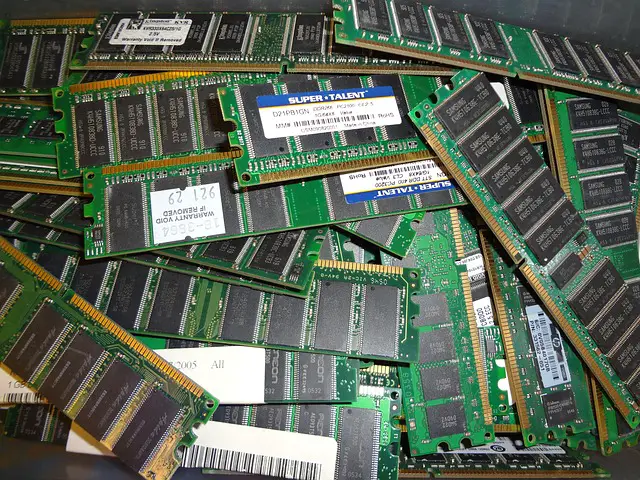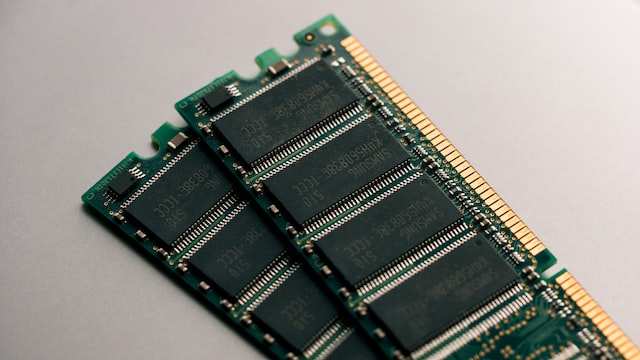The main difference between the two is that buffered RAM has a buffer between the CPU and the RAM, while unbuffered RAM does not. A buffered RAM is faster and more reliable than an Unbuffered RAM, but it is also more expensive. Buffered RAMs are typically used in servers and high-end PCs while unbuffered RAMs are used in more basic computers.
What is RAM?
(Image by Joshua Robins from Pixabay)

RAM, which stands for Random Access Memory, is a vital component of computer systems. It serves as a temporary storage space where data and instructions are stored while the computer is actively processing tasks. RAM plays a crucial role in the overall performance and speed of a computer.
RAM functions as a bridge between the computer’s processor (CPU) and its storage devices (hard drive or solid-state drive). Unlike permanent storage like the hard drive, RAM provides faster access to data and allows the CPU to quickly retrieve and manipulate information. This is because RAM is based on integrated circuits that can rapidly read and write data.
When a computer is turned on, the operating system and various programs are loaded into RAM. This allows the CPU to quickly access the necessary data and instructions, significantly speeding up the execution of tasks. The more RAM a computer has, the more data it can store and access without relying heavily on the slower storage devices.
RAM is characterized by its capacity and speed. Capacity refers to the amount of data that can be stored in RAM at a given time. It is typically measured in gigabytes (GB) or terabytes (TB). The required RAM capacity depends on the specific tasks and software being used. For example, complex applications like video editing software or gaming programs generally require more RAM.
The speed of RAM, measured in megahertz (MHz) or gigahertz (GHz), determines how quickly data can be accessed and transferred. Higher-speed RAM can improve overall system performance, particularly in tasks that involve large data transfers or multitasking.
It’s important to note that RAM is a type of volatile memory, meaning that its contents are lost when the computer is powered off or restarted. This is why it’s crucial to save any important data to permanent storage, such as the hard drive or cloud storage, to prevent data loss.
In summary, RAM is a crucial component of a computer system that provides temporary storage for data and instructions during active processing. It enables faster access to information, improves system performance, and allows for efficient multitasking. Understanding the capacity and speed requirements of RAM can help ensure optimal performance for various computing tasks.
Buffered RAM
Buffered RAM, also known as registered RAM or ECC RAM (Error-Correcting Code RAM), is a type of memory module used in computer systems. It incorporates an additional buffer between the memory controller and the memory chips. This buffer, consisting of registers, helps to enhance the stability and performance of the RAM.
The primary function of the buffer in buffered RAM is to reduce the electrical load on the memory controller by isolating and controlling the signals sent to the memory chips. This results in improved signal integrity and reduced noise, allowing for the use of larger memory modules and more reliable data transmission.
Buffered RAM also provides error correction capabilities, which is particularly valuable in critical applications where data integrity is crucial. The ECC feature allows the RAM to detect and correct single-bit errors, ensuring the accuracy and reliability of stored data.
However, buffered RAM has some considerations to keep in mind. It tends to have higher latency compared to unbuffered RAM due to the additional processing and signal buffering. Additionally, buffered RAM is generally more expensive and requires specific motherboard support, as not all systems are compatible with this type of memory.
Buffered RAM is a type of memory module that includes a buffer between the memory controller and memory chips. It provides enhanced stability, improved signal integrity, and error correction capabilities, making it suitable for applications that prioritize data accuracy and reliability.
Unbuffered RAM
Unbuffered RAM, also known as unregistered RAM or non-ECC RAM (Non-Error-Correcting Code RAM), is a type of memory module commonly used in computer systems. Unlike buffered RAM, unbuffered RAM does not incorporate an additional buffer between the memory controller and the memory chips.
Unbuffered RAM modules are designed to provide a simpler and more cost-effective solution for memory needs. They have lower latency compared to buffered RAM, as there is no additional signal buffering and processing involved. This allows for quicker data transfer and more immediate access to the stored information.
While unbuffered RAM does not offer the error correction capabilities of buffered RAM, it is suitable for most consumer applications where data integrity is not of critical importance. It is widely used in home computers, gaming systems, and standard office applications.
One advantage of unbuffered RAM is its compatibility with a wide range of computer systems. Most motherboards support unbuffered RAM, making it easier to upgrade or replace memory modules. Additionally, unbuffered RAM is typically more affordable than buffered RAM, making it a cost-effective option for users with budget constraints.
It’s worth noting that when mixing different types of RAM modules, such as buffered and unbuffered RAM, compatibility issues can arise. Therefore, it’s important to check the motherboard specifications and ensure that the memory modules used are compatible with each other and the system.
Unbuffered RAM is a common type of memory module used in consumer computer systems. It offers lower latency, affordability, and broad compatibility. While it lacks the error correction capabilities of buffered RAM, it serves as a reliable and cost-effective choice for most computing needs.
RAM – Buffered vs Unbuffered – Key differences
Buffered RAM and unbuffered RAM are two distinct types of memory modules with key differences. Here are the main points that set them apart:
Functionality:
Buffered RAM: Buffered RAM, also known as registered RAM, incorporates a buffer between the memory controller and the memory chips. This buffer helps improve signal integrity, reduce electrical load, and enhance stability. It is commonly used in servers and high-end workstations.
Unbuffered RAM: Unbuffered RAM, also known as unregistered RAM, lacks the buffer between the memory controller and memory chips. It provides a simpler and more cost-effective solution for memory needs. It is commonly used in consumer desktops, laptops, and standard office applications.
Latency:
Buffered RAM: Buffered RAM generally has higher latency due to the additional signal buffering and processing involved. This can result in slightly slower data transfer and access times.
Unbuffered RAM: Unbuffered RAM has lower latency compared to buffered RAM as it does not include the additional buffering and processing. This allows for quicker data transfer and more immediate access to the stored information.
Error Correction:
Buffered RAM: Buffered RAM often supports Error-Correcting Code (ECC), which provides error detection and correction capabilities. It can detect and correct single-bit errors, ensuring data integrity in critical applications.
Unbuffered RAM: Unbuffered RAM typically does not offer error correction capabilities. While this may be sufficient for most consumer applications, it may not be suitable for critical systems that require high data accuracy and reliability.
Compatibility and Cost:
Buffered RAM: Buffered RAM modules require specific motherboard support and compatibility. They are generally more expensive than unbuffered RAM due to the additional circuitry and features.
Unbuffered RAM: Unbuffered RAM modules are widely compatible with most consumer computer systems. They are more affordable compared to buffered RAM, making them a cost-effective option for standard computing needs.
Understanding these differences between buffered RAM and unbuffered RAM is crucial when selecting the appropriate type of memory for specific applications. Factors such as system requirements, performance needs, and budget considerations should be taken into account for an optimal memory choice.
Is buffered or unbuffered RAM better?
Determining whether buffered or unbuffered RAM is better depends on the specific requirements and use case. Here’s a breakdown:
Buffered RAM:
Advantages: Buffered RAM provides enhanced stability, improved signal integrity, and error correction capabilities (ECC). It is suitable for critical applications that prioritize data accuracy and reliability. It is commonly used in servers and high-end workstations.
Considerations: Buffered RAM tends to have higher latency, which can slightly impact performance. It is more expensive and requires specific motherboard support, limiting compatibility. It is typically not necessary for standard consumer systems.
Unbuffered RAM:
Advantages: Unbuffered RAM offers lower latency, affordability, and broad compatibility. It is suitable for most consumer applications, including home computers, gaming systems, and standard office tasks. It provides a cost-effective solution without sacrificing performance.
Considerations: Unbuffered RAM lacks error correction capabilities (ECC), which may not be crucial for non-critical applications. It may not be suitable for systems that require high data accuracy and reliability.
Ultimately, the choice between buffered and unbuffered RAM depends on the specific needs of the system. Buffered RAM is favored in situations where data integrity is paramount, such as server environments. Unbuffered RAM is typically sufficient and more cost-effective for standard consumer computing needs.
Featured Image By – Harrison Broadbent on Unsplash







